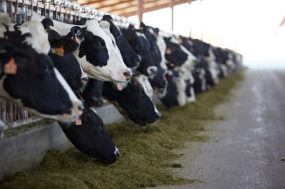To read this article in French, click here.
Reducing antimicrobial use in humans and animals is critical to combat resistance to commonly used antimicrobial treatments. We all need to work together to meet this challenge, and the dairy industry is taking action to do its part.
What is CaDNetASR?
The Canadian Dairy Network for Antimicrobial Stewardship and Resistance (CaDNetASR) was created to address the critical knowledge gap in antimicrobial use and antimicrobial resistance on Canadian dairy farms. The goal was to develop and implement an antimicrobial surveillance system to help understand antimicrobial use and antimicrobial resistance and improve antimicrobial stewardship.
From 2019 to 2022, data were collected on 144 dairy farms across five provinces to quantify herd-level antimicrobial use and detect herd-level antimicrobial resistance. This project included groups such as researchers from six Canadian universities (University of Prince Edward Island, University of Guelph, University of Saskatchewan, University of Montreal, University of Calgary and Memorial University), veterinary epidemiologists from the Public Health Agency of Canada, stakeholders from provincial and national milk organizations, veterinary organizations and dairy herd improvement organizations.
Antimicrobial usage on dairy farms in Canada
For each participating dairy farm, researchers used discarded drug containers to calculate the defined daily dose for each antimicrobial used to give a herd-level metric of antimicrobial use for comparison across farms. The defined daily dose for each participating farm was calculated and compared across others in the sample to estimate the antimicrobial usage. Drugs with the highest defined daily dose were: penicillins, first-generation cephalosporins, third-generation cephalosporins and tetracyclines.
When comparing antimicrobial use across various farms in this study, researchers saw a high amount of variability among participating farms, which suggests there is likely an opportunity for strategically reducing antimicrobial use on some Canadian dairy farms. Efforts will continue toward reducing antimicrobial use without compromising animal welfare and improving antimicrobial stewardship on dairy farms.
On-farm antimicrobial resistance
Researchers conducted an assessment of on-farm antimicrobial resistance by analyzing fecal samples and bulk tank milk samples from dairy farms. The CaDNetASR project aims to monitor foodborne pathogens, so a focus was placed on E. coli (generic strain), campylobacter spp. and salmonella spp.
The generic, non-pathogenic strain of E. coli was the most commonly found bacteria on farms (present in 96% of samples). E. coli was commonly found to be resistant to tetracycline, streptomycin and sulfisoxazole. Campylobacter spp. was less common than E. coli, but still widely present (present in 54% of samples). Campylobacter spp. most commonly showed resistance to tetracycline, in addition to nalidixic acid and ciprofloxacin. Found in approximately 7% of all samples, salmonella spp. showed resistance to tetracycline, sulfisoxazole and streptomycin.
Based on the results of this study:
- Tetracyclines were some of the highest-used antimicrobials across Canada.
- E. coli (generic strain), campylobacter spp. and salmonella spp. are commonly found on Canadian dairy farms.
- All three of these bacteria studied show resistance to tetracycline.
Calf health and antimicrobial use
Calves are a target area for reduced antimicrobial use because they are commonly treated with antimicrobials and they have a higher proportion of resistant and multidrug-resistant bacteria than older cattle. In this study, 30% of calves were treated at least once with an antimicrobial, with most antimicrobial treatments being given due to respiratory disease and diarrhea.
Farms that fed transition milk, i.e., milk produced between the second and sixth milkings following calving, gave fewer antimicrobial treatments than those who did not. Therefore, feeding transition milk may act as a management practice that could reduce disease and ultimately antimicrobial use.
Take-home messages
Antimicrobial use is an important challenge that needs to be addressed. Antimicrobial use and antimicrobial resistance have been investigated on Canadian dairy farms; however, work in these areas will continue to determine the best strategies to reduce antimicrobial use. On dairy farms, antimicrobial use in calves could be an important area to focus on to reduce antimicrobial use. Work with your veterinarian to determine management practices to limit disease and antimicrobial use on your farm.
This article was written by ACER Consulting; Javier Sanchez, professor; and Luke Heider, assistant professor, Atlantic Veterinary College, University of Prince Edward Island.
Dairy Farmers of Canada (DFC) invests in scientific research to foster innovation in the Canadian dairy sector. DFC supports research initiatives that benefit all Canadian dairy farmers and works in collaboration with its members and other sector partners to address priorities outlined in the National Dairy Research Strategy. The goals of this strategy are to increase farm efficiency and sustainability; enhance animal health, care and welfare practices; and strengthen the role of dairy in human nutrition and health, as well as in sustainable diets. Visit DFC Dairy Research for more information.








